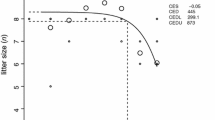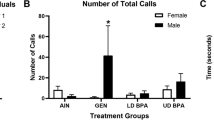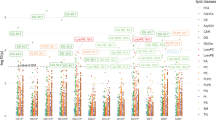Abstract
Phthalates are plasticizers finding wide spread use in industrial and household products, with measureable levels of phthalate-derived metabolites in the general US population. Phthalates have endocrine disruption potential and have been implicated as obesogens. Our exploratory investigation to reveal the impact of in utero exposure to a phthalate on the biochemical profiles of the brain, testes, and uterus of prepubertal offspring, and of tissues from dams administered butylbenzyl phthalate (BBP). Pregnant rats (three per group) were administered (on gestation day 14–21) corn oil (control), or 25 mg/kg/day or 750 mg/kg/day BBP in corn oil. Tissues were collected from each of the dams on postnatal day (pnd) 21 (~3 weeks after the end of BBP administration), and from each of the pups on pnd 26 (~4 weeks after birth to dams administered vehicle or BBP during gestation) and processed for metabolomics analysis. Multivariate data analyses revealed metabolites that best distinguished the exposed and control groups. The metabolites most important to distinguishing the study groups were tested for significance using the exact Wilcoxon rank-sum test. Male pups had significant differences (control versus BBP dose groups) in levels of metabolites for both the brain and testes even at the P < 0.01 level. However, female pups and dams had significant testing for the uterus only at the P = 0.1 level tested. Female pups also had some significant differences for the brain with P values between 0.5 and 0.1. Amino acid metabolism (male and female pups) and phospholipid metabolism (male pups) were perturbed for the brain. Amino acid metabolism, purine metabolism, and TCA cycle were perturbed for tests and uterus. This study demonstrated the use of metabolomics to reveal metabolic perturbations in tissues of offspring following in utero exposures, and suggests the use of this approach for determining the impact of exposure past the time of the presence of the parent compound and metabolites derived from the parent compound.




Similar content being viewed by others
References
Anway, M. D., Cupp, A. S., Uzumcu, M., & Skinner, M. K. (2005). Epigenetic transgenerational actions of endocrine disruptors and male fertility. Science, 308(5727), 1391–1392.
Beckonert, O., Keun, H. C., Ebbels, T. M. D., Bundy, J., Holmes, E., Lindon, J. C., et al. (2007). Metabolic profiling, metabolomic and metabonomic procedures for NMR spectroscopy of urine, plasma, serum and tissue extracts. Nature Protocols, 2(11), 2692–2703.
Bergh, A., Damber, J. E., & Hjertkvist, M. (1996). Human chorionic gonadotrophin-induced testicular inflammation may be related to increased sensitivity to interleukin-1. International Journal of Andrology, 19(4), 229–236.
Blount, B. C., Silva, M. J., & Caudill, S. P. (2000). Levels of seven urinary phthalate metabolites in a human reference population. Environmental Health Perspectives, 108(10), 972–982.
Crocker, J. F., Safe, S. H., & Acott, P. (1988). Effects of chronic phthalate exposure on the kidney. Journal of Toxicology and Environmental Health, 23(4), 433–444.
Ding, Y., Gao, Y., Shi, R., Zhou, Y. J., & Tian, Y. (2010). Effects of in utero exposure to di(2-ethylhexyl) phthalate on sexual development in female offspring. Chinese Journal of Preventive Medicine, 44(2), 150–153.
Draper, R. P., & Timbrell, J. A. (1996). Urinary creatine as a potential marker of testicular damage: Effect of vasectomy. Reproductive Toxicology, 10(1), 79–85.
Dym, M., & Fawcett, D. W. (1970). The blood-testes barrier in the rat and the physiological compartmentalization of the seminiferous epithelium. Biology of Reproduction, 3, 308–326.
Ebesunun, M. O., Solademi, B. A., Shittu, O. B., Anetor, J. I., Onuegbu, J. A., Olisekodiaka, J. M., et al. (2004). Plasma and semen ascorbic levels in spermatogenesis. West African Journal of Medicine, 23(4), 290–293.
Eriksson, L., Johansson, E., Kettaneh-Wold, N., Trygg, J., Wikström, C., & Wold, S. (2006). Multivariate and megavariate data analysis. Part I & Part II (2nd ed.). Umeå, Sweden: Umetrics Academy.
Fabian, R. H., & Hulsebosch, C. E. (1989). Time course of penetration of xenogeneic IgG into the central nervous system of the neonatal rat: An immunohistochemical and radionuclide tracer study. Journal of Neuroimmunology, 24, 183–189.
Fan, L. Q., Cattley, R. C., & Corton, J. C. (1998). Tissue-specific induction of 17 beta-hydroxysteroid dehydrogenase type IV by peroxisome proliferator chemicals is dependent on the peroxisome proliferator-activated receptor alpha. Journal of Endocrinology, 158, 237–246.
Fukuoka, M., Tanimoto, T., Zhou, Y., Kawasaki, N., Tanaka, A., Ikemoto, I., et al. (1989). Mechanism of testicular atrophy induced by di-n-butyl phthalate in rats. Part 1. Journal of Applied Toxicology, 9(4), 277–283.
Fukuoka, M., Zhou, Y., Tanaka, A., Ikemoto, I., & Michida, T. (1990). Mechanism of testicular atrophy induced by di-n-butyl phthalate in rats. Part 2. The effects on some testicular enzymes. Journal of Applied Toxicology, 10(4), 285–293.
Govindaraju, V., Young, K., & Maudsley, A. A. (2000). Proton NMR chemical shifts and coupling constants for brain metabolites. NMR in Biomedicine, 13, 129–153.
Grande, S. W., Andrade, A. J. M., Talsness, K. G., & Chahoud, I. (2006). A dose-response study following in utero and lactational exposure to di(2-ethylhexyl)phthalate: Effects of female rat reproductive development. Toxicological Sciences, 91(1), 247–254.
Gray, L. E., Jr, Ostby, J., Furr, J., Price, M., Veeramachaneni, D. N., & Parks, L. (2000). Perinatal exposure to the phthalates DEHP, BBP, and DINP, but not DEP, DMP, or DOTP, alters sexual differentiation of the male rat. Toxicological Sciences, 58(2), 350–365.
Griesmaier, E., & Keller, M. (2012). Glutamate receptors—prenatal insults, long-term consequences. Pharmacology, Biochemistry and Behavior, 100, 835–840.
Griffin, J. L., Troke, J., Walker, L. A., Shore, R. F., Lindon, J. C., & Nicholson, J. K. (2000). The biochemical profile of rat testicular tissue as measured by magic angle spinning 1H NMR spectroscopy. FEBS Letters, 486(3), 225–229.
Guerra, M. T., Scarano, W. R., de Toledo, F. C., Franci, J. A., & Kempinas, W.de. G. (2010). Reproductive development and function of female rats exposed to di-eta-butyl-phthalate (DBP) in utero and during lactation. Reproductive Toxicology, 29(1), 99–105.
Howdeshell, K. L., Rider, C. V., Wilson, V. S., & Gray, L. E., Jr. (2008a). Mechanisms of action of phthalate esters, individually and in combination, to induce abnormal reproductive development in male laboratory rats. Environmental Research, 108(2), 168–176.
Howdeshell, K. L., Wilson, V. S., Furr, J., Lambright, C. R., Rider, C. V., Blystone, C. R., et al. (2008b). A mixture of five phthalate esters inhibits fetal testicular testosterone production in the sprague-dawley rat in a cumulative, dose-additive manner. Toxicological Sciences, 105(1), 153–165.
Jouannet, P., Wang, C., Eustache, F., Kold-Jensen, T., & Auger, J. (2001). Semen quality and male reproductive health: The controversy about human sperm concentration decline. APMIS (Acta Pathologica, Microbiologica, et Immunologica Scandinavica), 109(5), 333–344.
Kalantaridou, S., Makrigiannakis, A., Zoumakis, E., & Chrousos, G. P. (2007). Peripheral corticotropin-releasing hormone is produced in the immune and reproductive systems: Actions, potential roles and clinical implications. Frontiers in Bioscience, 12, 572–580.
Kato, R., Maeda, T., Akaike, T., & Tamai, I. (2005). Nucleoside transport at the blood-testis barrier studied with primary-cultured sertoli cells. Journal of Pharmacology and Experimental Therapeutics, 312(2), 601–608.
Kato, R., Maeda, T., Akaike, T., & Tamai, I. (2006). Characterization of novel Na+-dependent nucleobase transport systems at the blood-testis barrier. American Journal of Physiology, Endocrinology, and Metabolism, 290, E968–E975.
Kavlock, R., Boekelheide, K., Chapin, R., Cunningham, M., Faustman, E., Foster, P., et al. (2002). NTP Center for the Evaluation of Risks to Human Reproduction: Phthalates expert panel report on the reproductive and developmental toxicity of butyl benzyl phthalate. Reproductive Toxicology, 16(5), 453–487.
Kunz, N., Camm, E. J., Somm, E., Lodygensky, G., Darbre, S., Aubert, M. L., et al. (2011). Developmental and metabolic brain alterations in rats exposed to bisphenol A during gestation and lactation. International Journal of Developmental Neuroscience, 29(1), 37–43.
Kuramori, C., Hase, Y., Hoshikawa, K., Watanabe, K., Nishi, T., Hishiki, T., et al. (2009). Mono-(2-ethylhexyl) phthalate targets glycogen debranching enzyme and affects glycogen metabolism in rat testis. Toxicological Sciences, 109(1), 143–151.
Kwack, S. J., Kim, K. B., Kim, H. S., & Lee, B. M. (2009). Comparative toxicological evaluation of phthalate diesters and metabolites in Sprague-Dawley male rats for risk assessment. Journal of Toxicology and Environmental Health, 72(21–22), 1446–1454.
Lehninger, A. L., Nelson, D. L., & Cox, A. M. (1997). Principles of biochemistry. New York, USA: Worth Publishers Inc.
Lindgren, A., Lindquist, N. G., Lyden, A., Olsson, T., & Ullberg, S. (1982). A whole body autoradiographic study on the distribution of 14C-labelled di(2-ethyl hexyl) phthalate in mice. Toxicology, 23, 149–158.
Liu, P., Lin, C., Pan, C., Kao, L., & Tseng, F. (2003). Butyl benzyl phthalate blocks Ca2+ signalling and catecholamine secretion couples with nicotinic acetylcholine receptors in bovine adrenal chromaffin cells. Neurotoxicology, 24(1), 97–105.
Lovekamp, T. N., & Davis, B. J. (2001). Mono-(2-ethylhexyl) phthalate suppresses aromatase transcript levels and estradiol production in cultured rat granulosa cells. Toxicology and Applied Pharmacology, 172(3), 217–224.
MacLusky, N. J., & Naftolin, F. (1981). Sexual differentiation of the central nervous system. Science, 211(4488), 1294–1302.
Maness, S. C., McDonnell, D. P., & Gaido, K. W. (1998). Inhibition of androgen receptor-dependent transcriptional activity by DDT isomers and methoxychlor in HepG2 human hepatoma cells. Toxicology and Applied Pharmacology, 151(1), 135–142.
Mazzei, P., Piccolo, A., Loredana, N., Mascolo, M., De Rosa, G., & Staibano, S. (2010). Metabolomic profile of intact tissue from uterine leiomyomas using high-resolution magic-angle-spinning 1H-NMR spectroscopy. NMR in Biomedicine, 23, 1–10.
Moore, N. P., Creasy, D. M., Gray, T. J., & Timbrell, J. A. (1992). Urinary creatine profiles after administration of cell-specific testicular toxicants to the rat. Archives of Toxicology, 66(6), 435–442.
Moore, N. P., Gray, T. J., & Timbrell, J. A. (1998). Creatine metabolism in the seminiferous epithelium of rats. II. Effect of modulators of cellular biochemical function on creatine secretion by cultured Sertoli cells. Journal of Reproduction and Fertility, 112(2), 331–336.
Moore, R. W., Rudy, T. A., Lin, T. M., Ko, K., & Peterson, R. E. (2001). Abnormalities of sexual development in male rats with in utero and lactational exposure to the antiandrogenic plasticizer di(2-ethylhexyl) phthalate. Environmental Health Perspectives, 109(3), 229–237.
Murature, D. A., Tang, S. Y., Steinhardt, G., & Dougherty, R. C. (1987). Phthalate esters and semen quality parameters. Biological Mass Spectrometry, 14(8), 473–477.
Mylchreest, E., Cattley, R. C., & Foster, P. M. D. (1998). Male reproductive tract malformations in rats following gestational and lactational exposure to di(η-butyl) phthalate: An antiandrogenic mechanism? Toxicological Sciences, 43(1), 47–60.
Mylchreest, E., Sar, M., Wallace, D. G., & Foster, P. M. (2002). Fetal testosterone insufficiency and abnormal proliferation of Leydig cells and gonocytes in rats exposed to di(n-butyl) phthalate. Reproductive Toxicology, 16(1), 19–28.
Naftolin, F., Ryan, K. J., Davies, I. J., Petro, Z., & Kuhn, M. (1975). The formation and metabolism of estrogens in brain tissues. Advances in Biosciences, 15, 105–121.
Nagao, T., Ohta, R., Marumo, H., Shindo, T., Yoshimura, S., & Ohno, H. (2000). Effect of butylbenzyl phthalate after gavage administration: A two-generation reproductive study. Reproductive Toxicology, 14(6), 513–532.
Nahas, K., le Net, J. L., Provost, J. P., & Tomaszewski, K. E. (1993). An investigation of urinary creatine excretion as a potential marker for testicular damage. Human and Experimental Toxicology, 12(2), 173–176.
Nicholson, J. K., Higham, D. P., Timbrell, J. A., & Sadler, P. J. (1989). Quantitative high resolution 1H NMR urinalysis studies on the biochemical effects of cadmium in the rat. Molecular Pharmacology, 36(3), 398–404.
Parkhie, M. R., Webb, M., & Norcross, M. A. (1982). Dimethoxyethyl phthalate: Embryopathy, teratogenicity, foetal metabolism and the role of the zinc in the rat. Environmental Health Perspectives, 45, 85–97.
Parks, L. G., Ostby, J. S., Lambright, C. R., Abbott, B. D., Klinefelter, G. R., Barlow, N. J., et al. (2000). The plasticizer diethylhexyl phthalate induces malformations by decreasing fetal testosterone synthesis during sexual differentiation in the male rat. Toxicological Sciences, 58(2), 339–349.
Pathmasiri, W., Snyder, R. W., Burgess, J. P., Popp, J. A., Fennell, T. R., & Sumner, S. C. J. (2011). Metabolomics of urine and liver for the assessment of acetaminophen induced liver injury. In D. A. Casciano & S. C. Sahu (Eds.), Handbook of Systems Toxicology (pp. 299–324). Sussex, UK: Wiley.
Pharikal, K., Das, P. C., Dey, C. D., & Dasgupta, S. (1988). Tissue ascorbate as a metabolic marker in cadmium toxicity. International Journal for Vitamin and Nutrition Research, 58(3), 306–311.
Ravenzwaay, B., Cunha, G. C., Strauss, B., Wiemer, J., Leibold, E., Kamp, H., et al. (2010). The individual and combined metabolite profiles (metabolomics) of dibutylphthalate and di(2-ethylhexyl)phthalate following a 28-day dietary exposure in rats. Toxicology Letters, 198(2), 159–170.
Rawcliffe, L., Creasy, D., & Timbrell, J. A. (1989). Urinary creatine as a possible marker for testicular damage: Studies with the testicular toxic compound 2-methoxyethanol. Reproductive Toxicology, 3(4), 269–274.
Rosner, B. (2000). Fundamentals of biostatistics (5th ed., pp. 343–347). Pacific Grove, CA: Duxbury.
Saillenfait, A. M., Payan, J. P., Fabry, J. P., Beydon, D., Langonne, I., Gallissot, F., et al. (1998). Assessment of the developmental toxicity, metabolism, and placental transfer of di-n-butyl phthalate administered to pregnant rats. Toxicological Sciences, 45(2), 212–224.
Shultz, V. D., Phillips, S., Sar, M., Foster, P. M., & Gaido, K. W. (2001). Altered gene profiles in fetal rat testes after in utero exposure to di(n-butyl) phthalate. Toxicological Sciences, 64(2), 233–242.
Singh, A. R., Lawrence, W. H., & Autian, J. (1975). Maternal-fetal transfer of 14C-di-2-ethylhexyl phthalate and 14C-diethyl phthalate in rats. Journal of Pharmaceutical Sciences, 64(8), 1347–1350.
Slupsky, C. M., Rankin, K. N., Wagner, J., Fu, H., Chang, D., Weljie, A. M., et al. (2007). Investigations of the effects of gender, diurnal variation, and age in human urinary metabolomic profiles. Analytical Chemistry, 79(18), 6995–7004.
Sumner, S., Burgess, J., Snyder, R., & Fennell, T. (2010a). Metabolomics of urine for the assessment of microvesicular lipid accumulation in the liver following isoniazid exposure. Metabolomics, 6(2), 238–249.
Sumner, S., Snyder, R., Fennell, T., Taylor, G., & Lewin, A. (2010b). Distribution of [14C] C60 in the pregnant and lactating rat and the effect on endogenous metabolism. Journal of Applied Toxicology, 30(4), 354–360.
Sumner, S., Snyder, R., Burgess, J., Tyl, R., & Fennell, T. (2010c). Omics in the study of reproduction and development. In R. Kapp & R. Tyl (Eds.), Reproductive toxicology (3rd ed., Chap. 22). London, UK: Informa Healthcare.
Sumner, S., Synder, R., Burgess, J., Myers, C., Tyl, R., Sloan, C., et al. (2009). Metabolomics in the assessment of chemical-induced reproductive and development outcomes using non-invasive biological fluids: Application to the study of butylbenzyl phthalate. Journal of Applied Toxicology, 29(8), 703–714.
Swan, S. H., Main, K. M., Liu, F., Stewart, S. L., Kruse, R. L., Calafat, A. M., et al. (2005). Decrease in anogenital distance among male infants with prenatal phthalate exposure. Environment Health Perspectives, 2005(113), 1056–1061.
Tabacova, S., et al. (1999). Maternal exposure to phthalates and complications of pregnancy. Epidemiology, 10(Suppl), S127.
Timbrell, J. A. (2000). Urinary creatine as a biochemical marker of chemical induced testicular damage. Archives of Industrial Hygiene and Toxicology, 51(3), 295–303.
Trygg, J., Holmes, E., & Lundstedt, T. (2007). Chemometrics in metabonomics. Journal of Proteome Research, 6, 469–479.
Tyl, R. W., Myers, C. B., Marr, M. C., Fail, P. A., Seely, J. C., Brine, D. R., et al. (2004). Reproductive toxicity evaluation of dietary butyl benzyl phthalate (BBP) in rats. Reproductive Toxicology, 18(2), 241–264.
Vitale, R., Fawcett, D. W., & Dym, M. (1973). The normal development of blood-testis barrier and the effects of clomiphene and estrogen treatment. Anatomical Record, 176(3), 331–344.
Weljie, A. M., Newton, J., Mercier, P. M., Carlson, E., & Slupsky, C. M. (2006). Targeted profiling: Quantitative analysis of 1H-NMR metabolomics data. Analytical Chemistry, 78(13), 4430–4442.
Wilson, V. S., Howdeshell, K. L., Lambright, C. S., Furr, J., Gray, E., & Jr, L. (2007). Differential expression of the phthalate syndrome in male Sprague-Dawley and Wistar rats after in utero DEHP exposure. Toxicology Letters, 170(3), 177–184.
Wilson, V. S., Lambright, C., Furr, J., Ostby, J., Wood, C., Held, G., et al. (2004). Phthalate ester-induced gubernacular ligament lesions are associated with reduced Insl3 gene expression in the fetal rat testis during sexual differentiation. Toxicology Letters, 146, 207–215.
Xu, Y., Agrawal, S., Cook, T. J., & Knipp, G. T. (2007). Di-(2-ethylhexyl)-phthalate affects lipid profiling in fetal rat brain upon maternal exposure. Archives of Toxicology, 81, 57–62.
Yamamoto, T., Horii, I., & Yoshida, T. J. (2007). Integrated NMR-based metabonomic investigation of early metabolic effects of ethylene glycol monomethyl ether (EGME) on male reproductive organs in rats. Toxicological Sciences, 32(5), 515–528.
Acknowledgments
Dr. Rochelle Tyl is appreciated for review and comment on this manuscript. The North Carolina Biotechnology Center is acknowledged for supporting laboratory supplies and an internship stipend for Mr. Ranjan Banerjee. Dr. Kevin Knagge of DHMRI is acknowledged for technical support. NIGMS Grant 5R21GM75903 provided funding for development of methods used in this investigation. The authors appreciate the review and suggestions by the journal referee, which has strengthened this manuscript.
Author information
Authors and Affiliations
Corresponding author
Rights and permissions
About this article
Cite this article
Banerjee, R., Pathmasiri, W., Snyder, R. et al. Metabolomics of brain and reproductive organs: characterizing the impact of gestational exposure to butylbenzyl phthalate on dams and resultant offspring. Metabolomics 8, 1012–1025 (2012). https://doi.org/10.1007/s11306-011-0396-y
Received:
Accepted:
Published:
Issue Date:
DOI: https://doi.org/10.1007/s11306-011-0396-y




